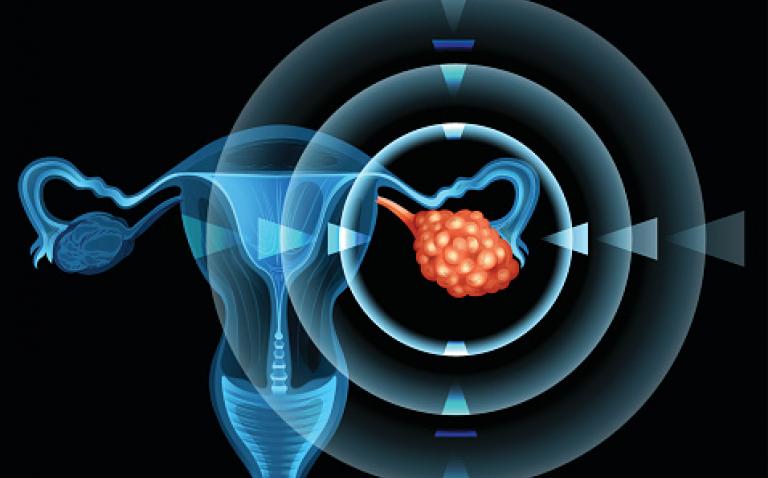AstraZeneca has reported new data from the Phase III SOLO-2 trial of Lynparza (olaparib) 300mg twice-daily tablet maintenance treatment showing that quality of life (QoL) is sustained alongside improved progression-free survival (PFS) in women with germline BRCA-mutated (gBRCAm), platinum-sensitive, relapsed serous ovarian cancer.1
On three separate rating scales (functional, physical well-being and symptoms), women receiving olaparib maintenance treatment reported similar QoL to those taking placebo, according to results presented at the 2017 ASCO Annual Meeting in Chicago, US, 2-6 June 2017.1 Significant ‘patient-centred benefits’ of olaparib vs placebo in quality-adjusted progression-free survival (QAPFS) and time without symptoms of disease or toxicity (TWiST) were observed up to 27 months after randomisation.
Eric Pujade-Lauraine, Head of the Women Cancers and Clinical Research Department at Hôpitaux Universitaires Paris Centre, site Hôtel-Dieu, AP-HP and Principal Investigator of SOLO-2, said: “This is very good news for patients because it suggests that olaparib not only has the potential to significantly prolong the amount of time they have before their disease progresses, but that additional time does not come at the cost of their quality of life. This may mean patients feel more able to adhere to maintenance treatment. This contrasts with what we have seen in the past with chemotherapy where the price of longer progression-free survival is often reduced quality of life leading to poor adherence to treatment.”
Sean Bohen, Executive Vice President, Global Medicines Development and Chief Medical Officer at AstraZeneca, said: “The olaparib quality of life data further support the potential benefit of this first-in-class PARP inhibitor as maintenance therapy for women with BRCA-mutated relapsed serous ovarian cancer. They strengthen our confidence in targeting DNA damage response (DDR) mechanisms to selectively kill cancer cells while minimising damage to healthy tissue which may cause adverse effects that impact negatively on quality of life for patients.”
Key QoL data from SOLO-2 include:1,2
- Primary endpoint for patient-reported outcomes (FACT-O TOI): No appreciable detrimental effect on quality of life for patients receiving maintenance treatment with olaparib versus patients on placebo -2.90 vs -2.87 respectively, difference -0.03, 95% confidence interval [CI] –2.19, 2.13; P=0.98)
- Quality-adjusted progression-free survival (QAPFS): Mean 13.96 vs 7.28 months for olaparib and placebo respectively (difference 6.68; 95% CI 4.98, 8.54; P<0.0001)
- Time without symptoms of disease or toxicity (TWiST): Significant improvement for patients on olaparib maintenance (13.5 vs 7.21 months, difference 6.29; 95% CI 2.95, 8.58; P<0.0001)
These data build on previously reported results of SOLO-2 which met its primary endpoint of investigator-assessed PFS (HR 0.30; 95% CI 0.22 to 0.41; P<0.0001; median 19.1 months vs 5.5 months).2 PFS as measured by Blinded Independent Central Review (BICR) evaluation, a pre-specified analysis supporting the primary endpoint, demonstrated a median PFS of 30.2 months vs 5.5 months for placebo, representing an improvement of 24.7 months (HR 0.25; 95% CI 0.18-0.35; P<0.0001). Earlier research also suggested the potential of olaparib as maintenance therapy in relapsed ovarian cancer.3
The 300mg twice-daily tablet dose, as used in SOLO-2, potentially reduces the existing pill burden for patients from 16 capsules to four tablets per day.
The safety profile for patients treated with olaparib tablets during the trial was consistent with that observed with the currently-approved capsule formulation.2 Any adverse events (AE) Grade ≥3 were reported in 36.9% of patients treated with olaparib and in 18.2% of patients who received placebo.2 The most common non-haematological AEs reported at a frequency of ≥20% were nausea (75.9% [grade ≥3, 2.6%]), fatigue/asthenia (65.6% [grade ≥3, 4.1%]),vomiting (37.4% [≥3, 2.6%]), diarrhoea (32.8% [≥3, 1.0%]) and abdominal pain (24.1% [≥3, 2.6%).2 The incidence of serious (grade ≥3) haematological AEs were 19.5%, 5.1% and 1.0% for anaemia, neutropenia and thrombocytopenia, respectively.4
References
- Friedlander M., et al. Relationship of health-related quality of life (HRQOL) and patient-centered outcomes with the clinical outcomes with olaparib maintenance following chemotherapy in patients with germline (g) BRCA-mutated (m) platinum-sensitive relapsed serous ovarian cancer (PSR SOC): SOLO2 phase III trial. Presented at the American Society of Clinical Oncology (ASCO), June 2 – 6, 2017. Chicago, Illinois, US
- Pujade-Lauraine E., et al. Treatment with olaparib monotherapy in the maintenance setting significantly improves progression-free survival in patients with platinum-sensitive relapsed ovarian cancer: Results from the Phase III SOLO2 Study. Presented at the Society of Gynecologic Oncology Annual Meeting on Women’s Cancer (SGO), March 12-15, 2017. National Harbor, Maryland, US.
- Ledermann J., et al. Olaparib Maintenance Therapy in Platinum-Sensitive Relapsed Ovarian Cancer. N Engl J Med 2012;366:1382-92.
- AstraZeneca Q1 2017 Results – Lynparza: Ovarian cancer – Compelling efficacy and safety (P25). Available at: https://www.astrazeneca.com/investor-relations/results-and-presentations…. Accessed May 2017.










